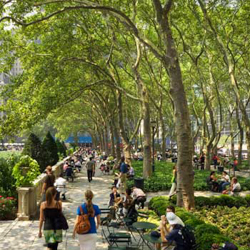Professional Practice
Adult: Asthma and Respiratory Disorders

The Centers for Disease Control and Prevention reports that 1 in 12 America adults suffer from asthma. In 2008, this resulted in 14.2 million missed days of work that cost the U.S. $56 billion in health care costs and lost productivity.
A recent study found that a 2.5 million deaths worldwide can be attributed to pollution and poor air quality. Ozone contributed to the death of 470,000 people. Some 2.1 million deaths resulted from fine particulate matter in the air.
How Nature Helps
While there is no cure for asthma, one of its main triggers is air pollution. Planting more trees is proven to lessen air pollution and improve air quality, which in turn contributes to healthier air, lungs, and residents.
 ASLA 2010 Professional Landmark Award, Bryant Park, NYC. OLIN / Image credit: Peter Mauss, Esto
ASLA 2010 Professional Landmark Award, Bryant Park, NYC. OLIN / Image credit: Peter Mauss, Esto  ASLA 2007 Professional General Design Honor Award, The Red Ribbon — Tanghe River Park, Turenscape (Beijing Turen Design Institute) and Peking University Graduate School of Landscape Architecture / Image credit: Kongjian Yu, Cao Yang
ASLA 2007 Professional General Design Honor Award, The Red Ribbon — Tanghe River Park, Turenscape (Beijing Turen Design Institute) and Peking University Graduate School of Landscape Architecture / Image credit: Kongjian Yu, Cao YangResearch
"Modeled PM2.5 Removal by Trees in Ten US Cities and Associated Health Effects," Environmental Pollution, 2013
"The Relationship between Trees and Human Health: Evidence from the Spread of the Emerald Ash Borer," American Journal of Preventative Medicine, 2013
"Sustaining America's Urban Trees and Forests," U.S. Forest Service, 2010
“Children Living In Areas With More Street Trees Have Lower Prevalence Of Asthma,” Journal of Epidemiology & Community Health, 2008
Resources
Urban Forests = Cooler, Cleaner Air, ASLA
"Parks are Part of Our Healthcare System," The Dirt blog
How Cities Use Parks to Improve Public Health, American Planning Association
In Mexico City, a City's Scar Becomes its Most Prized Park, The Atlantic Cities
Organizations
One Million Trees NYC
Chicago Trees Initiative
Million Trees LA
Role of the Landscape Architect
Adding more trees to the built environment is critical in combating air pollution, and landscape architects did just that in projects like Bryant Park in New York City, which provides ample tree cover as well as cleaner, cooler air.
Large-scale naturalistic parks in cities, like Tanghe River Park in Qinhuangdao City, China, work hard to scrub the air of pollution created by cars and industry.
Landscape architects plant street trees throughout communities, expanding the urban forest which helps to both clean and cool the air we breath.
Case Studies
Bryant Park, New York City, New York, OLIN
Tanghe River Park, Qinhuangdao City, China, Turenscape
<< Alzheimer's and Dementia
Cognition >>